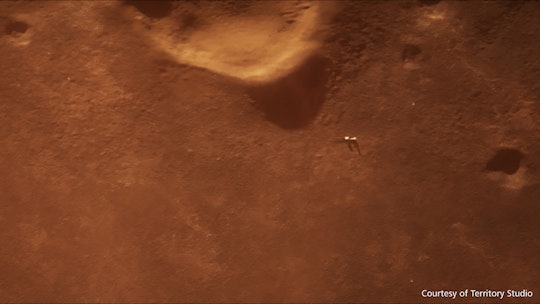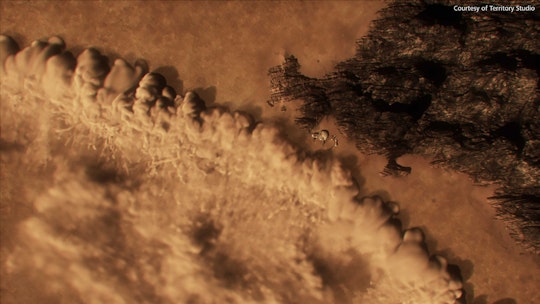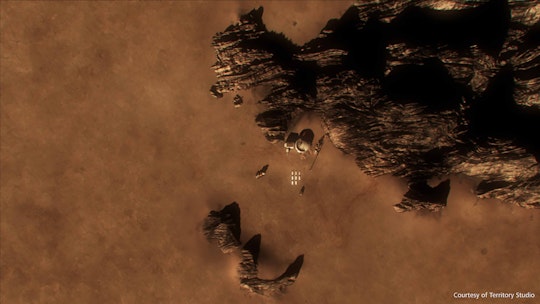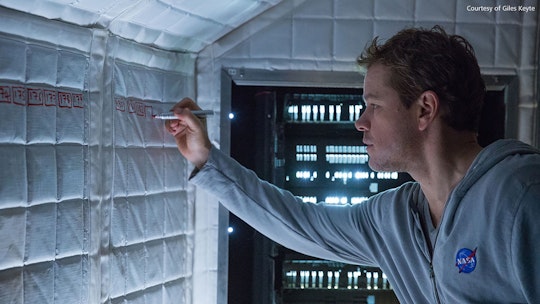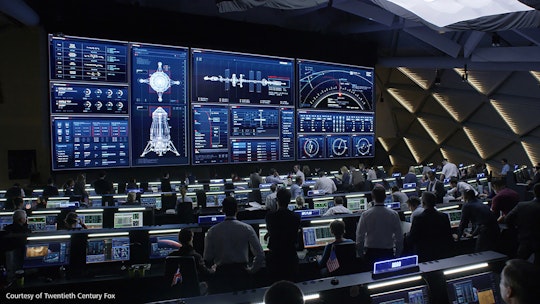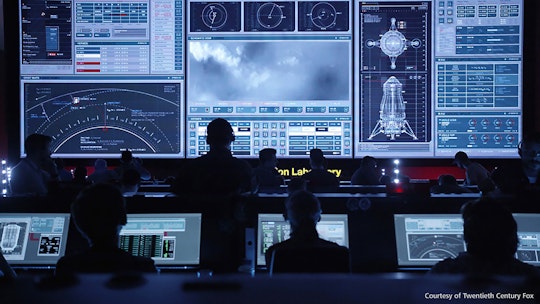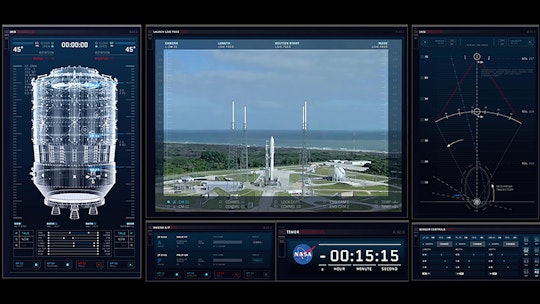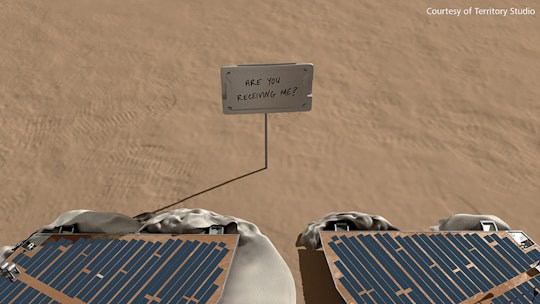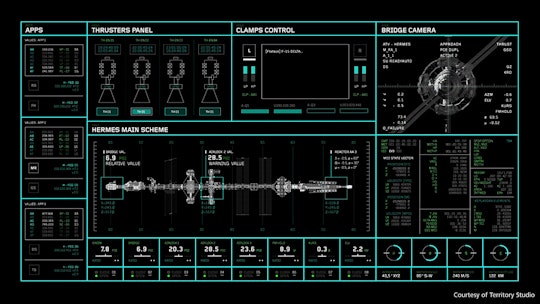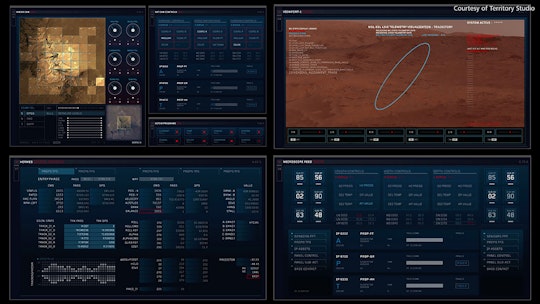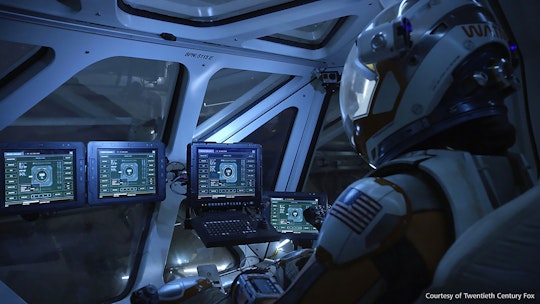
Bringing the Martian to Life Discover how Territory Studio used Cinema 4D to create convincing on-set technology for Ridley Scott's Golden Globe awarded sci-fi thriller.
Creating on-screen graphics for actors to interact with and relate to is a specialty of London-based Territory Studio. However, when those screens have to be scientifically accurate or coherent in terms of existing NASA technology and practices, it becomes a whole different ballgame. That was the challenge facing David Sheldon-Hicks, founder and creative director of Territory Studio. Fortunately, having already worked on massive sci-fi projects like Jupiter Ascending and with Ridley Scott on Prometheus, David had a good idea of what was going to be required and how Cinema 4D could help make it happen.
In the seven months it took to create The Martian, five artists at Territory created around 400 screens across eight different sets, and Mission Control alone featured almost 100 screens. The displays and animations were all for live playback on with which the actors to engaged. Most of them were interactive as well.
The film was based on Andy Weir's best-selling novel about stranded astronaut Mark Watney. It's set 20 years in the future and tells the story of NASA's third manned mission to Mars. The key concept was that the plot, and thus the on-set screen displays, was fixed in real science rather than fanciful popcorn sci-fi. This meant that Territory had to research the science being used before getting started with any of the designs.
David explains what was involved: "It was an incredible amount of research, from poring over reference photos of Mission Control and JPL at NASA provided by Dave Lavery, Program Executive for Solar System Exploration at NASA, to vehicle schematics, and the Pathfinder transmission specs. Plus, how NASA received and decoded messages. And, knowing that NASA is always one step ahead of current technology, we had to imagine ways to represent things, thinking about technologies they are testing now or have not even started developing. We also needed to understand what the on-screen data feeds meant and why they were necessary and when they came into play. Sometimes it felt like a crash course in rocket science and space exploration - it was definitely interesting but it also made the work more challenging to try and get our heads around."
Art Director Marti Romances pointed out how everyone was on a learning curve: "I have to say I learned a lot about things and how they work that I hadn't known before this project. For instance, knowing what material the camera is pointing to by shooting a laser at it and analyzing the light reaction from it. Learning how all those things work to be as authentic as we could was a big challenge."
Peter Eszenyi, head of 3D, explained what he had to do: "My role was to design and deliver 3D plates, renders and animations to be used in the on-set screens. Initially, the brief was to develop a look and create animations that show the location of the HAB on Mars in different lighting conditions and states. One of the crucial moments in the film is when NASA figures out that Watney is alive by looking at satellite images of the area and realizing that the solar panels have been cleaned. This initial brief was extended to show the giant storm around the HAB, the rover driving through various regions on Mars, creating the pictures that the Pathfinder beamed back from the surface of Mars, creating various 3D elements for the screens such as launch simulations, potatoes, soil samples and so on."
The team used Sketch and Toon plus the standard cel renderer for some of the wireframe meshes, and they used X-Particles with the standard renderer to render the more particle-based assets like the potato displays, soil sample screens and the dust storm.
One of the more challenging areas was the actual NASA Mission Control set because of the need for realism but in a slightly futuristic setting. David Sheldon-Hicks explained how Territory approached it: "With a brief to remain authentic to current data conventions, we researched all the screens that Dave Lavery had forwarded. We studied what data was prioritized and when, how that was organized and depicted on screen and in the Mission Control space, and how the crew interacted with it. It included what commands were given and how that changed the data display. We also talked to NASA about how they think that will evolve over the next 20 years. Once our research had been finished, we created a visual language that was very true to the data requirements and the spirit of NASA's current Mission Control. The backgrounds we chose were black and dark blue with white fonts and light blue indicators. Red was used to highlight mission critical data and indicate warning status. The overall look of the interface is serious and authoritarian but the hierarchy of information is clearly readable to tie in with story points."
On the screens where the terrain is being displayed, along with the dust story, it steps away from the technical, scientific look to show actual landscapes. To create these, Territory obtained a very low-resolution model of the area in Jordan, which doubled for the Mars surface. The team used the plugin DemEarth for that. However, since the available dataset was not detailed enough they remodeled the area based on satellite and location photographs. Sub-polygon displacement was used for the mountains. Proxy models were used for the HAB, the solar panels and the Rovers and those were swapped with the high-resolution models supplied by the production. Since the exact coordinates of the actual location as well as the shoot dates were known, it was possible to create accurate lighting setups for the relevant hours. X-Particles was used to simulate the base of the dust storm and a smoke simulation on top of that was created with TurbulenceFD.
As the screens were live on set for the actors to interact with, last-minute changes were sometimes requested. One example was to change the size of a crater, which was initially around a kilometer or so in size, to be 100 kilometers wide. Cinema 4D made it easy to remodel the crater and when the size was approved, details could be quickly added to the base mesh. The standard renderer was used, so it was very fast to create the final frames with the changes applied.
For the interactive screens, most requests from the production were for image sequences for Territory's on-set engineering partners at Compuhire to program. They had to be programmed to display images that refreshed within in a realistic time-frame, and the animations and simulations were usually reduced to one image every three seconds. Other screens were programmed to simulate typing scenes from the crew's laptops or Mission Control computers. So no matter what the actors were typing, the right message appeared on screen.
David explains the workflow required to create the interface graphics for the MAV simulator that astronaut Martinez uses from the main ship (the Hermes): "It was all designed in Adobe Illustrator and featured some interactive buttons that had to be pressed on-set following a sequence. We isolated all the interactive buttons to be programmed for the on-set performance. In the middle of that screen we had to render a visualization for each stage of that remote-controlled probe. So we animated and rendered each different stage of the lift off of the MAV in a way that could be triggered on-set, connected with those buttons. The MAV 3D renders were done in Cinema 4D using a wireframe pass to achieve a more realistic look."
With all the design work being done during the day, most of the rendering work was done overnight on individual 3.5GHz, six-core Intel Macs. After seven months of intense science, Peter Eszenyi, head of 3D, summed it up with, "As always, Cinema 4D was a reliable tool that gave us all the options we needed to create the huge number of screens for Ridley Scott's The Martian."
Territory was naturally delighted when The Martian won 'Best Motion Picture Musical Or Comedy' at the 2016 Golden Globe Awards, held at the Beverly Hilton in Los Angeles, California. It was the second win of the night for the film. The Martian actor Matt Damon took home 'Best Performance by an Actor in a Motion Picture Musical or Comedy.' Ridley Scott was also nominated in the 'Best Director - Motion Picture' category. See more at: www.goldenglobes.com.
You can see more of the on-set screen graphics from The Martian here:
www.territorystudio.com
